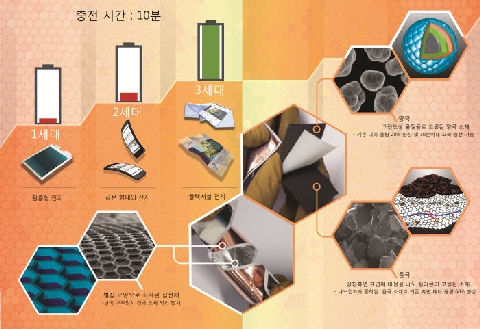An original technology for a 1mm-thick flexible secondary battery, which can be charged in just 10 minutes, has been developed. It is expected that a thin and light quick-charging high-performance battery will be commercialized earlier than initially thought.
Prof. Cho Jae-pil, School of Energy and Chemical Engineering, Ulsan National Institute of Science and Technology (UNIST), and his team, announced on July 31 that they developed this battery by applying the nano technology to the electrode material and current collector, the core of the lithium secondary battery. The existing flexible battery takes about an hour to charge, but the new battery can be charged 100% in just 10 minutes. It will remain stable after the 200-bend test.
The research team used the nickel oxide system instead of the lithium cobalt oxide, the current anode material to improve the charging capacity by 20%. Also, they coated the surface with the mixed oxide containing vanadium to improve electronic conductivity more than two times, and improve lithium ion mobility more than three times.
As the cathode material, the expanded graphite, which has 13 times more electronic conductivity than the natural graphite, was used. The surface was coated with 10nm or less amorphous silicon particles to improve battery capacity by about 60%.
The current collector surface was cut in the shape of a nanostructure honeycomb, and consequently the adhesive strength was improved about 1.7 times. Thanks to this, even after repeated bending, the peeling of the electrode material could be prevented.
It is now bendable while satisfying the performance requirements of all commercialized existing secondary batteries. It can be used for wearable devices including flexible smartphones.
The research was conducted under the sponsorship of the Ministry of Science, ICT and Future Planning’s new technology convergence-type growth engine project, and introduced in the July issue of ‘Nano Letters,’ an international academic journal.
Park Jae-moon, head of the R&D Policy Bureau of the Ministry of Science, ICT and Future Planning, said, “We will try our best policy-wise to make sure that outstanding researches capable of leading a new industry can lead to commercialization without being wasted.”
Song Joon-yeong | songjy@etnews.com
10분 만에 충전되는 플렉시블 전지 개발
10분 만에 충전되는 1㎜ 두께 플렉시블 이차전지 원천기술이 개발됐다. 얇고 가벼우면서도 충전이 빠른 고성능 전지 상용화가 앞당겨질 것으로 기대된다.
조재필 울산과학기술대학교(UNIST) 에너지및화학공학부 교수팀은 리튬 이차전지 핵심인 전극 소재와 집전체에 나노 기술을 적용해 이 같은 전지를 개발했다고 31일 밝혔다. 기존 플렉시블 전지 충전에 약 1시간이 소요되는 데 반해 10분 만에 100% 충전이 가능하다. 200회 구부림 테스트에서도 안정성을 유지한다.
연구진은 현재 양극 소재로 쓰이는 리튬코발트산화물 대신 니켈산화물계를 사용해 충전 용량을 20% 향상시켰다. 또 바나듐이 함유된 복합산화물을 표면에 입혀 전자전도도를 2배 이상, 리튬이온 이동도를 3배 이상 각각 개선했다.
음극 소재로는 천연 흑연보다 전자전도도가 13배 이상 높은 팽창흑연을 사용했다. 표면에 10나노미터(㎚) 이하 비정질 실리콘 입자를 코팅해 전지 용량을 약 60% 향상시켰다.
집전체 표면을 나노구조 벌집 모양 형태로 삭각한 결과 접착력이 약 1.7배 향상됐다. 덕분에 구부림을 반복해도 전극 소재 박리 현상을 막을 수 있었다.
상용화된 기존 이차전지의 모든 성능을 만족하면서도 구부림 특성이 추가된 셈이다. 플렉시블 스마트폰 등 웨어러블 기기 전반에 활용할 수 있다.
연구는 미래창조과학부 신기술 융합형성장동력사업 지원을 받아 수행됐고, 국제학술지 ‘나노레터스’ 7월호에 소개됐다.
박재문 미래부 연구개발정책실장은 “새로운 산업을 견인할 수 있는 우수한 연구 성과가 사장되지 않고 상용화로 이어지도록 정책적 노력을 다할 것”이라고 강조했다.
송준영기자 | songjy@etnews.com
